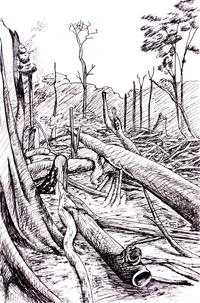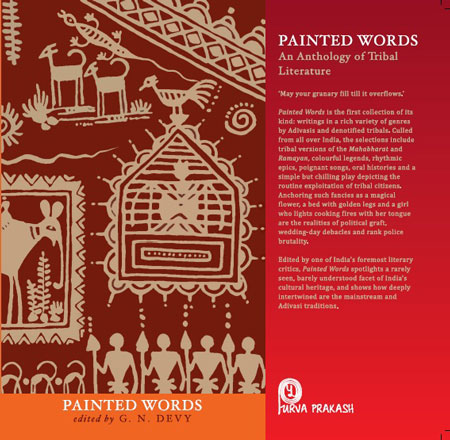“Mahasweta Devi had people in tears at this year’s Frankfurt Book Fair. Delivered with passionate heart, her inaugural speech about our freedoms still on hold stirs a kind of moral transformation” | Excerpts and PDF-backup of her full speech titled “The Republic of Dreams”
At 80-plus I move forward often stepping back into the shadows. Sometimes I am bold enough to step back into the sunlight. As a young person, as a mother, I would often move forward to when I was old. Amuse my son. Pretend I couldn’t hear or see. Make mockery of memory, forget things that had happened a moment ago. These games were for fun. Now they are no longer funny. My life has moved forward and is repeating itself. I am repeating myself. Recollecting for you what has been. What is. What could have been. May have been.

“We can do things differently to reinvent growth without pollution. But only if we have the courage to think differently.” – Sunita Narain in Down To Earth >>
See the tree, the forest, the field lush with crops, a stream dazzling in sunlight. And see, the spotted deer are jumping and fleeing to the forest, the mothers are filling the pitchers from the stream, clutching their children. And the houses are the ones they left behind at Badihatta. The sun is leaning to see the earth. The peasants are irrigating their fields. What an expanse of forest. How green the hills are. […]
Since the 1980s, I have been vocal about the daily injustice and exploitation faced by the most marginalised and dispossessed of our people: tribals, the landless rural poor who then turn into itinerant labour or pavement dwellers in cities. Through reports in newspapers, through petitions, court cases, letters to the authorities, participation in activist organisations and advocacy, through the grassroots journal I edit, Bortika, in which the dispossessed tell their own truths, and finally through my fiction, I have sought to bring the harsh reality of this ignored segment of India’s population to the notice of the nation, I have sought to include their forgotten and invisible history in the official history of the nation. I have said over and over, our Independence was false; there has been no Independence for these dispossessed peoples, still deprived of their most basic rights.
How to save and protect one’s culture in these circumstances? Which culture do we protect? And what do we mean when we speak of Indian culture in the 21st century? What culture? Which India? Sixty years after our hard-won Independence, the khadi sari is India just as the mini skirt and the backless choli is. A bullock cart is India just as much as is the latest Toyota or Mercedes car. Illiteracy haunts us, yet the same India produces men and women at the forefront of medicine, science and technology. Eight-year-old children toil mercilessly, facing unimaginable working conditions and abuse as child labourers. That is India. On the other hand, there is another lot of eight-year-olds who spend their time in air-conditioned classrooms and call their mothers at lunch break using their personal mobile phones. That too is India. Satyam Shivam Sundaram is India. Choli ke peechchey kya hai is also India. The multiplex and the mega mall are India. The snake charmer and the maharishi — they too are India. […]
There’s a story about Nanak — his father made him sit in a shop, told him to sell goods… dus, gyarah, barah, tera… tera, tera, tera… and he gave everything away. Everything is yours. With me, everything became tera… nothing touches the inside. Material things don’t touch me, I remain an outsider, I can’t always be an insider. Genuine warmth, real understanding, some friendship, a few strange things touch me, but I’m an outsider and an insider at the same time. […]
I have tried in my own way to give you a picture of this culture. But how am I to even to begin arriving at a definition that will be acceptable to all across an India that is so chaotic. So calm. So flexible. So rigid. So rich. So poor. So understanding. So easy to be misunderstood. After all, there are many Indias, as I say over and over again. Simultaneous. Even parallel.
And whose culture is it anyway? Yours? Mine? Theirs? There are so many ‘theirs’ in the land of my birth who have nothing but the harsh landscape of surviving from day to day. The dispossessed remain with us after six decades of becoming possessed of a freedom we all fought for. They all fought for.
I claim elsewhere to have always written about the ‘culture of the downtrodden’. How tall or short or true or false is this claim? The more I think and write and think some more, the harder it gets to arrive at a definition. I hesitate. I falter. I cling to the belief that for any culture as old and ancient as ours to have survived over time and in time, there could only be one basic common and acceptable core thought: humaneness. To accept each other’s right to be human with dignity.
This then is my fight. My dream. In my life and in my literature.
Source: “The Republic of Dreams” delivered by Mahasweta Devi in Frankfurt on 21 Oct 21 October 2006 in Tehelka – The People’s Paper
Address : http://tehelka.com/story_main20.asp?filename=hub102106The_republic.asp
Date Visited: Sat Aug 18 2012 15:55:53 GMT+0200 (CEST)
Backup of the full speech (PDF, 278 KB)
[Bold typeface added above for emphasis]
Tips for using interactive maps
Toggle to normal view (from reader view) should the interactive map not be displayed by your tablet, smartphone or pc browser
For details and hyperlinks click on the rectangular button (left on the map’s header)
Scroll and click on one of the markers for information of special interest
Explore India’s tribal cultural heritage with the help of another interactive map >>
See also
Adverse inclusion | Casteism | Rural poverty
Demographic Status of Scheduled Tribe Population of India (Census figures 2011)
Fact checking | Figures, census and other statistics
Human Rights Commission (posts) | www.nhrc.nic.in (Government of India)
Search tips | Names of tribal communities, regions and states of India
“What is the Forest Rights Act about?” – Campaign for Survival and Dignity
“Who are Scheduled Tribes?” – Government of India (National Commission for Scheduled Tribes, NCST)
“India, a union of states, is a Sovereign, Secular, Democratic Republic with a Parliamentary system of Government. The President is the constitutional head of Executive of the Union. In the states, the Governor, as the representative of the President, is the head of Executive. The system of government in states closely resembles that of the Union. There are 28 states and 8 Union territories in the country. Union Territories are administered by the President through an Administrator appointed by him/her. From the largest to the smallest, each State/UT of India has a unique demography, history and culture, dress, festivals, language etc. This section introduces you to the various States/UTs in the Country and urges you to explore their magnificent uniqueness…” – KnowIndia (Government), States and Union Territories (Visited: 2 September 2023)
Learn more about India’s 28 States and 8 Union Territories – From Andhra Pradesh to West Bengal | Nutrition >>
“Tribal groups (adivasis) in India have often been excluded, marginalized and oppressed by ‘mainstream’ society. In many ways this exclusion, marginalization and oppression is fostered by the way in which ‘mainstream’ society looks at the adivasis – as exotic, dangerous, or ‘primitive’ others.” – Ganesh [G.N.] Devy in A Nomad Called Thief: Reflections on Adivasi Silence and Voice | Classifications in different states >>
“The tribal world and the tribal way is complete in itself.” – Mahasweta Devi quoted by Gopalkrishna Gandhi in “Swearing by Mahasweta” (The Hindu, 6 August 2016)
